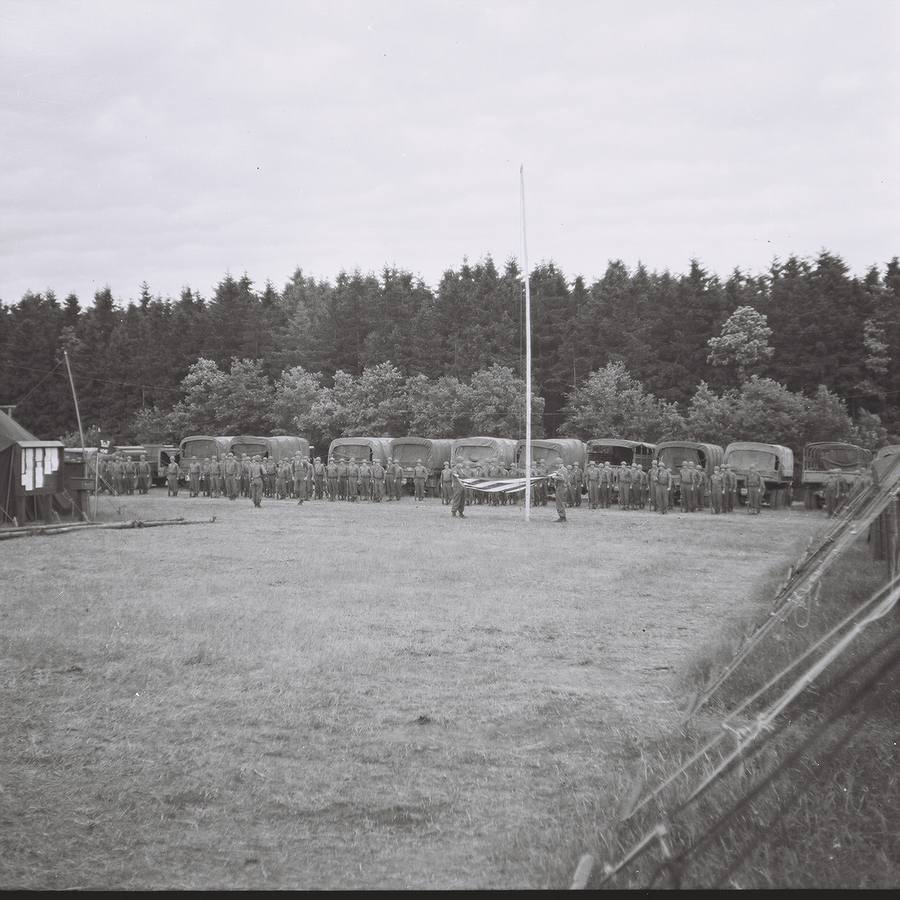D-Day

Likely taken in England. From the collection of Irving Mayer.
June 1st ushered in the one and only “problem” held by 23d Hq in England. It was a demonstration of the rubber dummies and the third platoon represented the 406th on this maneuver. With Lt Aliapoulos commanding, the platoon accompanied “B” Company of the 603rd to Thetford, Norfolkshire.
The entire group reached their assembly area the evening of June 1st and pitched camp. The next day, the outfits moved to the problem sector which was a wooded area near Thetford.
To the third platoon was assigned the mission of providing the security round this area in which an armored division was being simulated. Each squad was given a specific section to guard with orders to arrest any unauthorized persons entering the problem area.
During the night, as the men guarded, the 603rd installed the armored division and a dummy air strip for the rubber liaison planes. They were assisted in this work by the third Platoons air compressor and personnel.
By morning the installation was complete. That day, June 2nd, American and British officers from SHEAF viewed the work and pictures were taken from the air.
The same afternoon, the demonstration over, the installations were taken down and the whole group moved back to the assembly area for the night.
On this problem the men had their first encounter with “K” rations which were the sole food ration provided. After two meals, foraging parties were born. Bread, sugar, butter, eggs and other foodstuffs were enjoyed with the next meal. The experiences of these parties were of value throughout the company’s E.T.O. tour.
On the morning of June 4th the entire party returned to Walton Hall.
Those in charge of recreation were not idle at Walton Hall. As a result, the most popular spot in the camp during the evening hours was the P.X. It was installed in a large Niesen hut near the “Castle.“ At first there was just a combination store and tape room. A cinema was soon added and this made the 23d recreation center complete.
The morning of June 6th found half the company standing guard around the working area and the other half either attending classes or working on the “hill.” An unusual number of gliders had been noticed by the men the day before but the men had assumed that it was normal air activity.
When the news of “D” day ran through the camp, the previous day’s glider activity and the night guards’ stories of large plane formations were recalled. These had been the company’s only signs that the long planned storm was about to break on the shores of France.
As the men discussed the news reports on the bulletin board, many recalled that Capt. Rebh had said in his judgment the week of June 5th would see the invasion started. When would the company be called on to play its part?
On June 7th, a very interesting practical course on the activating and deactivating of mines and booby traps was started under the supervision of Lt. Robinson. Three small sections in the camp were taped off for the classes. Two platoons worked in these areas the course of the day.
In the morning, one platoon would assign each of its squad a section. The squads would plant booby traps and lay activated mines through the taped off enclosure. Small blocks of T.N. T. were used on three of the activated mines in each section. Care was taken to see that these small blocks were buried outside the tapes, well away from the defused mines. The booby traps set off British Thunder Flashes.
The three squads would work all morning in their respective sections. At noon, the work finished, the areas were left under guard until the arrival of the other platoon that was scheduled to run the course at 1300 hours.
The deactivating platoon would also give each of its squads a section to clear. In clearing the area, the men used all the techniques that had been taught them in numerous classes and field instructions.
The clearing platoon would set the areas up again the next morning for another group to work on in the afternoon. Much practical knowledge was obtained from this course and the men enjoyed both the laying and picking up of the various devices.
Despite numerous precautions, one accident occurred. On July 9th, Pfc. Rogers was seriously injured about the face when a device he was activating went off. It was ascertained that the positive pin in the firing device had been removed before the safety pin. As a result, when the safety pin was pulled, the defectively set device exploded. It was a costly mistake and made a deep impression on the men who took the course.